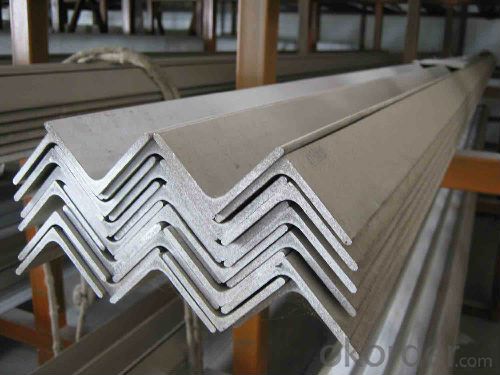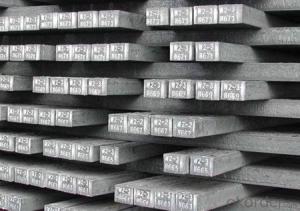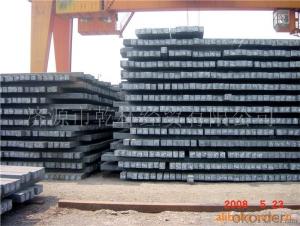Steel Equal Angle 20MM-250MM GB Q235 20-250MM
- Loading Port:
- Tianjin
- Payment Terms:
- TT or LC
- Min Order Qty:
- 25 m.t.
- Supply Capability:
- 200000 m.t./month
OKorder Service Pledge
OKorder Financial Service
You Might Also Like
Product Description:
OKorder is offering high quality Hot Rolled Steel I-Beams at great prices with worldwide shipping. Our supplier is a world-class manufacturer of steel, with our products utilized the world over. OKorder annually supplies products to European, North American and Asian markets. We provide quotations within 24 hours of receiving an inquiry and guarantee competitive prices.
Product Applications:
According to the needs of different structures, Angle can compose to different force support component, and also can be the connections between components. It is widely used in various building structures and engineering structures such as roof beams, bridges, transmission towers, hoisting machinery and transport machinery, ships, industrial furnaces, reaction tower, container frame and warehouse etc
Product Advantages:
OKorder's Steel I-Beams are durable, strong, and resist corrosion.
Main Product Features:
· Premium quality
· Prompt delivery & seaworthy packing (30 days after receiving deposit)
· Corrosion resistance
· Can be recycled and reused
· Mill test certification
· Professional Service
· Competitive pricing
Product Specifications:
Manufacture: Hot rolled
Grade: Q195 – 235
Certificates: ISO, SGS, BV, CIQ
Length: 6m – 12m, as per customer request
Packaging: Export packing, nude packing, bundled
Sizes: 25mm-250mm | ||||||||||||
a*t | ||||||||||||
25*2.5-4.0 | 70*6.0-9.0 | 130*9.0-15 | ||||||||||
30*2.5-6.6 | 75*6.0-9.0 | 140*10-14 | ||||||||||
36*3.0-5.0 | 80*5.0-10 | 150*10-20 | ||||||||||
38*2.3-6.0 | 90*7.0-10 | 160*10-16 | ||||||||||
40*3.0-5.0 | 100*6.0-12 | 175*12-15 | ||||||||||
45*4.0-6.0 | 110*8.0-10 | 180*12-18 | ||||||||||
50*4.0-6.0 | 120*6.0-15 | 200*14-25 | ||||||||||
60*4.0-8.0 | 125*8.0-14 | 250*25 | ||||||||||
FAQ:
Q1: Why buy Materials & Equipment from OKorder.com?
A1: All products offered byOKorder.com are carefully selected from China's most reliable manufacturing enterprises. Through its ISO certifications, OKorder.com adheres to the highest standards and a commitment to supply chain safety and customer satisfaction.
Q2: How do we guarantee the quality of our products?
A2: We have established an advanced quality management system which conducts strict quality tests at every step, from raw materials to the final product. At the same time, we provide extensive follow-up service assurances as required.
Q3: The products are invoicing on theoritical weight or on actual weight?
A3: We can do it in both manners, according to the customers' request.


- Q:Are steel billets used in the aerospace industry?
- Yes, steel billets are used in the aerospace industry. They are often used as raw materials for manufacturing various components and parts, such as engine components, landing gear, and structural supports. Steel billets offer excellent strength and durability, making them suitable for aerospace applications that require high-performance materials.
- Q:What are the different methods of steel billet cutting?
- There are several different methods of steel billet cutting, each with its own advantages and applications. Some of the most common methods include: 1. Sawing: Sawing is a traditional method of cutting steel billets using a saw blade. It can be done manually or with the help of a machine. Sawing is a versatile method that can be used for cutting various sizes and shapes of billets, but it may not be suitable for cutting thicker billets. 2. Flame cutting: Flame cutting, also known as oxy-fuel cutting, involves using a torch to heat the steel billet to its ignition temperature and then introducing a stream of oxygen to create a chemical reaction that cuts through the metal. This method is commonly used for cutting thicker billets and can be used for both straight cuts and beveled cuts. 3. Plasma cutting: Plasma cutting is a process that uses a high-velocity jet of ionized gas to melt and remove the steel. It is a versatile method that can be used for cutting various thicknesses of steel billets and can produce high-quality cuts with minimal heat-affected zones. 4. Water jet cutting: Water jet cutting utilizes a high-pressure stream of water mixed with abrasive particles to cut through the steel billet. This method is ideal for cutting complex shapes and can produce precise cuts with minimal heat-affected zones. Water jet cutting is also suitable for cutting a wide range of materials, including metals, plastics, and composites. 5. Laser cutting: Laser cutting uses a focused laser beam to melt and vaporize the steel billet, creating a narrow cut. This method is highly precise and can produce intricate cuts with minimal heat-affected zones. Laser cutting is commonly used for cutting thin to medium thickness billets and is especially popular in industries that require high precision and speed. In summary, the different methods of steel billet cutting include sawing, flame cutting, plasma cutting, water jet cutting, and laser cutting. Each method has its own strengths and is suitable for different applications based on factors such as billet thickness, desired precision, and type of material being cut.
- Q:What are the common applications of steel billets?
- Steel billets are commonly used as raw material for the production of various steel products, such as bars, rods, wire, pipes, and tubes. They are also utilized in the automotive industry for manufacturing parts like crankshafts, camshafts, and gears. Additionally, steel billets find applications in construction for producing structural elements like beams, columns, and girders.
- Q:How do steel billets contribute to the chemical industry?
- The chemical industry heavily relies on steel billets as a vital raw material for the production of various chemicals and chemical products. These solid bars or rods of steel play a critical role in the manufacturing process. To begin with, in chemical production plants, steel billets are utilized in the fabrication of reactors and vessels. These reactors are specifically designed to withstand extreme temperatures and pressure. Steel billets provide the necessary strength and durability to ensure the integrity of these applications. The chemical reactions occurring within these reactors often involve corrosive or harsh chemicals, and the use of steel billets guarantees that the equipment remains intact, preventing any potential leaks or accidents. Furthermore, steel billets are also essential in the production of catalysts, substances that facilitate chemical reactions without being consumed in the process. Many catalysts are composed of metals or metal oxides, and steel billets are commonly employed as the foundational material for their manufacturing. By providing a stable and robust foundation, steel billets contribute to the efficiency and effectiveness of these catalysts. Additionally, steel billets are employed in the construction of pipelines and storage tanks, which are crucial for the transportation and storage of chemicals. These structures must withstand high pressures and corrosive environments, making steel billets the preferred material due to their strength, durability, and resistance to chemical degradation. They ensure the secure and efficient transportation and storage of chemicals, which is of utmost importance in the chemical industry. In conclusion, steel billets are indispensable in the chemical industry due to their strength, durability, and resistance to chemical degradation. They are utilized in the construction of reactors, vessels, catalysts, pipelines, and storage tanks, all of which are vital components of chemical production and transportation. Without steel billets, the chemical industry would face significant challenges in operating efficiently and safely.
- Q:What are the common defects in billet? What's the cause?
- 4. Tungsten inclusion;Six, arc scratch and heat crack and overlap: 1:Two reheat cracks 3 cracks
- Q:Are steel billets subject to any regulations or certifications?
- Steel billets must adhere to numerous regulations and certifications to guarantee their production, quality, and safety standards are met. The ISO 9001 certification, an internationally recognized standard for quality management systems, is one of the most common certifications for steel billets. This certification ensures that the manufacturing process of steel billets follows consistent quality control measures, from sourcing raw materials to final production. Steel billets may also need to obtain industry-specific certifications, depending on their intended use. For example, if the steel billets are intended for construction projects, they must comply with certifications such as ASTM standards or European EN standards. These certifications define the necessary mechanical properties, chemical composition, and other specifications that steel billets must meet to ensure they are suitable for construction purposes. In addition, governmental bodies or industry associations may impose regulations on steel billets. These regulations can include safety standards, environmental regulations, and compliance with trade policies. For instance, steel billet producers may need to comply with regulations regarding emissions, waste management, or occupational health and safety. In conclusion, various regulations and certifications are in place to ensure the quality, safety, and compliance with industry standards of steel billets. These certifications and regulations are crucial for maintaining the integrity of steel billets and ensuring they are suitable for various applications.
- Q:How do steel billets contribute to the manufacturing of textile machinery?
- Due to their mechanical properties and versatility, steel billets are crucial in the manufacturing of textile machinery. Essentially semi-finished steel products, they come in rectangular or square shapes and serve as raw material in various industries, including textile machinery manufacturing. The manufacturing of textile machinery greatly benefits from steel billets, particularly in the production of structural components. These components, such as frames and supports, require durability and sturdiness for stability and efficient functioning. Steel billets, with their high strength and rigidity, are an ideal choice for these components. They can be easily shaped, machined, or welded to create intricate and complex structures capable of withstanding the heavy loads and vibrations associated with textile machinery. Steel billets also find application in the production of moving parts like shafts and gears. These parts must possess excellent wear resistance, high tensile strength, and good machinability to ensure smooth operation and a long service life. Through processes such as forging, rolling, or machining, steel billets can be transformed into these crucial parts, providing the necessary mechanical properties and precision required in textile machinery. Furthermore, steel billets are extensively used in the manufacturing of tooling and molds for textile machinery production. These tools and molds are essential for shaping and forming various components. By subjecting steel billets to heat treatment and precise machining processes, they can be transformed into high-quality tooling and molds that offer exceptional dimensional accuracy and durability. This significantly contributes to the overall efficiency and quality of textile machinery production. In conclusion, steel billets play a pivotal role in textile machinery manufacturing by providing raw material for structural components, moving parts, and tooling. Their mechanical properties, versatility, and ease of fabrication make them indispensable in the industry. Steel billets ensure the durability, precision, and functionality of textile machinery, ultimately enhancing the overall performance and reliability of the equipment.
- Q:What is the process of hot rolling steel billets?
- The process of hot rolling steel billets involves heating the billets to a high temperature and then passing them through a series of rollers to reduce their thickness and shape them into desired forms such as sheets, plates, or bars. This process improves the mechanical properties of the steel and enhances its overall quality and usability.
- Q:What are the main factors affecting the dimensional accuracy of steel billets?
- The main factors affecting the dimensional accuracy of steel billets include the quality of the raw materials used, the temperature and cooling rate during the casting process, the design and condition of the casting equipment, and the skill and experience of the operators.
- Q:How are steel billets used in the production of turbine blades?
- Steel billets are used in the production of turbine blades as raw material. These billets are first forged into the desired shape and then undergo precision machining to achieve the required dimensions and finish. The steel billets provide the strength and durability necessary to withstand the high temperatures and forces experienced by turbine blades during operation.
1. Manufacturer Overview |
|
|---|---|
| Location | |
| Year Established | |
| Annual Output Value | |
| Main Markets | |
| Company Certifications | |
2. Manufacturer Certificates |
|
|---|---|
| a) Certification Name | |
| Range | |
| Reference | |
| Validity Period | |
3. Manufacturer Capability |
|
|---|---|
| a)Trade Capacity | |
| Nearest Port | |
| Export Percentage | |
| No.of Employees in Trade Department | |
| Language Spoken: | |
| b)Factory Information | |
| Factory Size: | |
| No. of Production Lines | |
| Contract Manufacturing | |
| Product Price Range | |
Send your message to us
Steel Equal Angle 20MM-250MM GB Q235 20-250MM
- Loading Port:
- Tianjin
- Payment Terms:
- TT or LC
- Min Order Qty:
- 25 m.t.
- Supply Capability:
- 200000 m.t./month
OKorder Service Pledge
OKorder Financial Service
Similar products
New products
Hot products
Related keywords





























